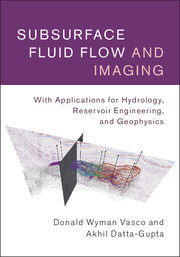 Subsurface Fluid Flow and Imaging
Subsurface Fluid Flow and Imaging Book contents
- Frontmatter
- Contents
- Preface
- Acknowledgments
- 1 The propagation of a disturbance in relation to imaging
- 2 Principles and equations governing fluid flow and deformation
- 3 Trajectory-based modeling
- 4 Equations in diffusion form
- 5 Equations governing advection and transport
- 6 Immiscible fluid flow
- 7 Coupled deformation and fluid flow
- 8 Appendix: a guide to the accompanying software
- References
- Index
- Colour plate section between pages 150 and 151
7 - Coupled deformation and fluid flow
Published online by Cambridge University Press: 05 July 2016
- Frontmatter
- Contents
- Preface
- Acknowledgments
- 1 The propagation of a disturbance in relation to imaging
- 2 Principles and equations governing fluid flow and deformation
- 3 Trajectory-based modeling
- 4 Equations in diffusion form
- 5 Equations governing advection and transport
- 6 Immiscible fluid flow
- 7 Coupled deformation and fluid flow
- 8 Appendix: a guide to the accompanying software
- References
- Index
- Colour plate section between pages 150 and 151
Summary
Introduction
With the continuing development of techniques for monitoring fluid flow using remote observations, there is an increasing need to model the associated deformation of the porous rock containing the fluid. Such modeling helps us understand displacements induced by fluid flow, as observed by geodetic methods and seismic time strains. Coupled modeling also provides insight into the deformation-induced flow associated with the passage of an elastic wave. Understanding this phenomena, and its relationship to the properties of a porous medium, are critical for effective time-lapse monitoring of fluid flow. Time-lapse monitoring provides a basis for the inverse problem: the determination of the properties of a porous medium using remote observations. In this chapter we develop solutions for coupled deformation and fluid flow. While one goal is the resulting efficiency associated with trajectory-based solutions for both forward and inverse modeling, the insight provided by the semi-analytic solutions is equally important to our understanding. The end result of our efforts will be similar to what we found in earlier chapters: an equation for the phase and for the trajectories. The primary difference will be the appearance of multiple phase velocities, revealing the existance of elastic-like fast waves, and slow diffusion-like modes of propagation.
In this chapter we consider two important situations in which the governing equations simplify. First, when a single fluid is present in a poroelastic medium, the non-linearity due to saturation-dependent properties disappears and the resulting equations are linear for small strain rates. Second, for the small but rapid displacements associated with the passage of an elastic wave through a poroelastic medium, we can linearize the equations about the existing saturation distribution.
Deformation in a porous body containing a single fluid
The governing equations
For fluid injection over a time period during which viscoelastic and plastic behavior are not significant, one may model the reservoir and the surrounding regions as a poroelastic medium. In this approximation, we assume that the porous skeleton behaves elastically while the injected material behaves as a Newtonian viscous fluid. We are free to adopt the constitutive models and the coupling terms discussed in Chapter 2. Thus, we can begin with the governing Equations (2.154) and (2.155).
- Type
- Chapter
- Information
- Subsurface Fluid Flow and ImagingWith Applications for Hydrology, Reservoir Engineering, and Geophysics, pp. 285 - 326Publisher: Cambridge University PressPrint publication year: 2016


